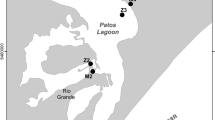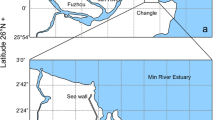Abstract
The primary factors that control the concentration of total reduced (inorganic) sulfide in coastal sediments are believed to be the availability of reactive iron, dissolved sulfate and metabolizable organic carbon. We selected nine sites in shallow (<3 m), close to sub-tropical, estuaries and bays along the central Texas coast that represented a range in sediment grain size (a proxy for reactive iron), salinity (a proxy for dissolved sulfate), and total organic carbon (a proxy for metabolizable organic carbon). Based on these parameters a prediction was made of which factor was likely to control total reduced sulfide at each site and what the relative total reduced sulfide concentration was likely to be. To test the prediction, the sediments were analyzed for total reduced sulfide, acid volatile sulfide, and citrate dithionate-extractable, HCl-extractable and total Fe in the solid phase. Using solid-state gold–mercury amalgam microelectrodes and voltammetry, we determined pore water depth profiles of Fe(II) and ΣH2S and presence or absence of FeS(aq). At five of the nine sites the calculated degree of sufildization of citrate dithionite-reactive-iron was close to or greater than 1 indicating that rapidly reactive iron was probably the limiting factor for iron sulfide mineral formation. At one site (salinity = 0.9) dissolved Fe(II) was high, ΣH2S was undetectable and the total reduced sulfide concentration was low indicating sulfate limitation. At the last three sites a low degree of sulfidization and modest total reduced (inorganic) sulfide concentrations appeared to be the result of a limited supply of metabolizable organic carbon. Fe(II)–S(-II) clusters (FeS(aq)) were undetectable in 10 out of 12 bay sediment profiles where ΣH2S was close to or below detection limits, but was observed in all other porewater profiles. Acid volatile sulfide, but not total reduced sulfide, was well correlated with total organic carbon and ranged from being undetectable in some cores to representing a major portion of total reduced sulfide in other cores. Although predicted controls on total reduced sulfide were good for very low salinity water or sandy sediments, they were only right about half the time for the other sediments. The likely reasons for the wrong predictions are the poor correlation of total organic carbon with grain size and differing fractions of metabolizable organic carbon in different sedimentary environments. Differences in sediment accumulation rates may also play a role, but these are difficult to determine in this region where hurricanes often resuspend and move sediments. This study demonstrates the need to examine more complex and often difficult to determine parameters in anoxic “normal marine” sediments if we are to understand what controls the concentration and distribution of sulfides.



Similar content being viewed by others
References
Aller RC (1980) Diagenetic processes near the sediment–water interface of Long Island Sound. II. Fe and Mn. Adv Geophys 22:351–415
Behrens EW (1969) Hurricane effects on a hypersaline bay. Lagunas Costeras, un Simposio. Mem. Simp. Intern. Lagunas Costeras. UNAM-UNESCO, Nov. 28–30, 1967. Mexico, D.F., 301–312
Berner RA (1970) Sedimentary pyrite formation. Am J Sci 268:1–23
Berner RA (1982) Burial of organic carbon and pyrite sulfur in the modern ocean: its geochemical and environmental significance. Am J Sci 282:451–473
Bianchi TS (2006) Biogeochemistry of estuaries. Oxford University Press, Oxford
Boesen C, Postma D (1988) Pyrite formation in anoxic environments of the Baltic. Am J Sci 288:575–603
Boudreau BP (1997) Diagenetic models and their implementation. Springer, Berlin
Brendel PJ, Luther GW III (1995) Development of a gold amalgam voltammetric microelectrode for the determination of dissolved Fe, Mn, O2, and S(-II) in porewaters of marine and freshwater sediments. Environ Sci Technol 29:751–61
Canfield DE (1989) Reactive iron in marine sediments. Geochim Cosmochim Acta 53:619–632
Canfield DE, Raiswell R, Westrich JT, Reaves CM, Berner RA (1986) The use of chromium reduction in the analysis of reduced inorganic sulfur in sediments and shales. Chem Geol 54:149–155
Canfield DE, Raiswell R, Bottrell S (1992) The reactivity of sedimentary iron minerals toward sulfide. Am J Sci 292:659–683
Cornwell JC, Morse JW (1987) The characterization of iron sulfide minerals in anoxic marine sediments. Mar Chem 22:193–206
Eldridge PM, Morse JW (2000) A diagenetic model for sediment-seagrass interactions. Mar Chem 70:89–104
Leventhal J, Taylor C (1990) Comparison of methods to determine the degree of pyritization. Geochim Cosmochim Acta 54:2621–2625
Luther GW III, Giblin AE, Howarth RW, Ryans RA (1982) Pyrite and oxidized iron mineral phases formed from pyrite oxidation in salt marsh and estuarine sediments. Geochim Cosmochim Acta 46:2671–2676
Martens CS, Klump JV (1984) Biogeochemical cycling in an organic-rich coastal marine basin 4. An organic carbon budget for sediments dominated by sulfate reduction and methanogenesis. Geochim Cosmochim Acta 48:1987–2004
Morse JW (1999) Sulfides in sandy sediments: new insights on the reactions responsible for sedimentary pyrite formation. Aquat Geochem 5:75–85
Morse JW, Berner RA (1995) What controls sedimentary C/S ratios? Geochim Cosmochim Acta 59:1073–1077
Morse JW, Wang Q (1997) Pyrite formation under conditions approximating those in anoxic sediments: II. Influence of precursor iron minerals and organic matter. Mar Chem 57:187–193
Morse JW, Cornwell JC, Arakaki T, Lin S, Huerta-Diaz MA (1992) Iron sulfide and carbonate mineral diagenesis in Baffin Bay, Texas. J Sed Petrol 62:671–680
Raiswell R, Canfield DE (1996) Rates of reaction between silicate iron and dissolved sulfide in Peru Margin sediments. Geochim Cosmochim Acta 60:2777–2788
Raiswell R, Canfield DE (1998) Sources of iron for pyrite formation in marine sediments. Am J Sci 298:219–245
Raiswell R, Canfield DE, Berner RA (1994) A comparison of iron extraction methods for the determination of degree of pyritization and the recognition of iron-limited pyrite formation. Chem Geol 111:101–110
Rickard D, Morse JW (2005) Acid volatile sulfide (AVS). Mar Chem 97:141–198
Roychoudhury AN, Kostka JE, Van Cappellen P (2003) Pyritization: a paleoenvironmental and redox proxy reevaluated. Estua Coastal Shelf Sci 57:1183–1193
Rozan TF, Taillefert M, Trouwborst RE, Glazer BT, Ma S (2002) Iron–sulfur–phosphorus cycling in the sediments of a shallow coastal bay: implications for sediment nutrient release and benthic macroalgal blooms. Limnol Oceanog 47:1346–1354
Acknowledgements
This research was primarily supported by funds from the Louis and Elizabeth Scherck Endowed Chair in Oceanography. We thank Dr. Wayne Gardner and Mark McCarthy at the University of Texas Marine Science Institute and Chen Xu for assistance in obtaining sediment samples. Lori Law and Janie Lee assisted in analyzing samples.
Author information
Authors and Affiliations
Corresponding author
Rights and permissions
About this article
Cite this article
Morse, J.W., Thomson, H. & Finneran, D.W. Factors Controlling Sulfide Geochemistry in Sub-tropical Estuarine and Bay Sediments. Aquat Geochem 13, 143–156 (2007). https://doi.org/10.1007/s10498-007-9012-1
Received:
Accepted:
Published:
Issue Date:
DOI: https://doi.org/10.1007/s10498-007-9012-1




